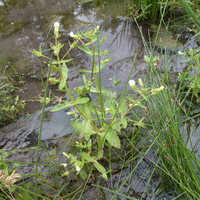Infrequent to frequent throughout the state except in the northern tier of counties. It grows in moist or wet soil in bare places, and, where it is found, it often forms large colonies. My notes say "abundant over an acre or more in acid soil in a one year old, fallow cornfield in Warren County," and "abundant over more than an acre in moist, sandy soil in a fallow field about 2 miles northwest of Monticello, White County." It is most often found in old logging roads, about old hog wallows, and on the borders of dried-up ponds.
General: Annual, 5-20 cm tall; stems ascending to decumbent, simple to branched; herbage glandular-puberulent to sometimes nearly glabrous; roots fibrous.
Leaves: Cauline, opposite, oblanceolate to obovate, 1-5 cm long, mostly 3-10 mm wide, glandular-puberulent to nearly glabrous, margins minutely dentate in the upper half or sometimes entire throughout, apex acute, base slightly clasping; blades sessile.
Flowers: Inflorescence a head-like spike, these 2-10 flowered, terminating the branches; outer bracts of 1 or more subtending each spike, these leaf-like, 1-2.5 cm long, similarly divided as the leaves, often more so, the divisions filiform; inner bract subtending each flower narrowly lanceolate, 1.5-2.5 cm long, margins entire or sometimes pinnately divided into 3-5 apical lobes; calyx narrowly lanceolate to linear, 1.5-2 cm long, the apex cleft; corolla tubular, bilabiate, 1.6-2.4 cm long, yellow to purplish or marked with purple, the lips nearly equal; stamens 4; flowers July-October.
Fruits: Capsule, mostly septicidal, globose-ovoid, 3.5-5.5 mm long; seeds numerous, minute, light brown.
Ecology: Moist habitats, pond and lake margins, often in mud; 2000-2400 m (6500-8000 ft); Apache, Coconino, and Navajo counties; widely distributed throughout North America.
Notes: na
Editor: Springer et al. 2008
Annual; stems 1-3 dm, glandular-pubescent; lvs lanceolate to oblanceolate, 2-5(-6) cm, narrowed from near or above the middle to the base; pedicels very slender, widely divergent, 1-2 ( + ) cm; bractlets equaling or surpassing the cal; sep lanceolate, 4-6 mm; cor 8-10 mm, the lobes white, the tube yellowish; fr 3-5 mm; 2n=16. Wet soil; Que. to B.C., s. to Ga. and Ariz.; our most abundant sp. May-July, also again in autumn, and often then with cleistogamous fls. (G. virginica, misapplied)
Gleason, Henry A. & Cronquist, Arthur J. 1991. Manual of vascular plants of northeastern United States and adjacent Canada. lxxv + 910 pp.
©The New York Botanical Garden. All rights reserved. Used by permission.







